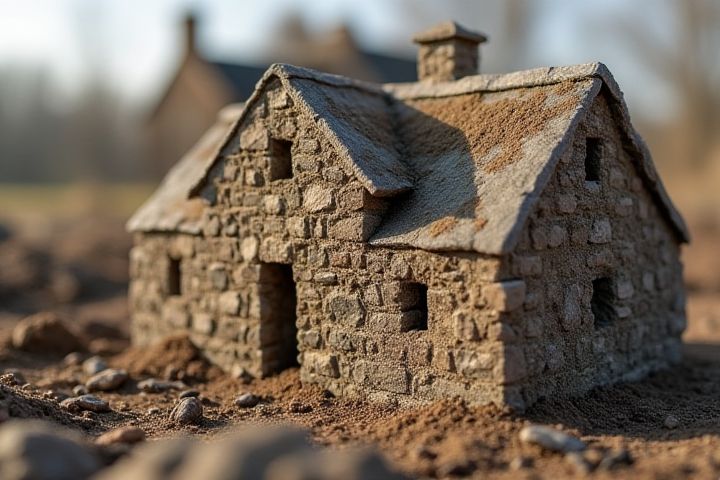
House foundations can indeed shift due to various factors, including soil conditions, moisture levels, and temperature fluctuations. Poor drainage systems can lead to water accumulation around the foundation, causing soil erosion or expansion, which affects stability. Trees and large shrubs planted too close can also contribute to foundation movement as their roots may absorb moisture or apply pressure to the surrounding soil. Signs of a shifting foundation include cracks in walls, uneven floors, and doors that no longer close properly. Regular inspections and proper maintenance can help mitigate these issues, ensuring the long-term integrity of your home's foundation.
Can House Foundations Shift
Soil expansion and contraction
Soil expansion and contraction significantly impact house foundations, particularly in clay-rich regions. When moisture levels fluctuate, expansive clay can swell up to 15% in volume, exerting substantial pressure on foundation walls. Conversely, during dry seasons, soil contraction leads to a reduction in support, potentially causing cracks or settling in the foundation. Understanding local soil conditions and implementing proper drainage can mitigate these risks, ensuring your home's stability over time.
Poor drainage
Poor drainage can significantly contribute to house foundation shifts, leading to structural damage. When water accumulates around the foundation due to inadequate drainage systems, it increases soil saturation, causing the ground to expand and contract with temperature changes. Studies indicate that approximately 40% of foundation problems stem from water-related issues, emphasizing the importance of proper drainage solutions. Regular maintenance and the installation of drainage systems, such as French drains or sump pumps, can protect your foundation and enhance the longevity of your home.
Tree root growth
Tree root growth can significantly impact house foundations, especially when roots extend close to or beneath the structure. Invasive roots, particularly from species like willow or cottonwood, can exert pressure on concrete, leading to cracks or uneven settling. Research indicates that roots can penetrate up to 25 feet horizontally from the tree base, affecting soil stability and moisture levels around the foundation. Homeowners should consider maintaining a distance of at least 10 to 15 feet between large trees and structures to reduce the risk of foundation shifting.
Earthquakes
House foundations can shift significantly during earthquakes, resulting in structural damage. Studies indicate that as little as 0.4 inches of movement can compromise the integrity of a foundation. Proper seismic design, including reinforced concrete and flexible materials, can mitigate these risks. You should consider retrofitting older homes to enhance stability and reduce the potential for foundation displacement.
Improper construction
Improper construction techniques can lead to significant shifting in house foundations, resulting in structural instability. Poor soil conditions, inadequate drainage, and insufficient reinforcement can exacerbate this issue, causing cracks and misalignment in walls and floors. It's crucial to ensure that foundational support is appropriately designed and executed according to local building codes and engineering standards. Regular inspections and maintenance can help you identify early signs of foundation movement and address them before they escalate.
Nearby construction activities
House foundations can shift due to nearby construction activities, primarily from vibrations and soil disruption. Excavation work can lead to soil compaction or loosen soil around your property, compromising stability. Heavy machinery may create ground vibrations that can propagate through the earth, leading to cracks in your foundation. You should monitor any signs of shifting, such as cracks in walls or doors that stick, and consult a structural engineer if necessary to assess the impact.
Flooding
House foundations can shift significantly due to flooding, particularly when soil saturation leads to increased hydrostatic pressure. A study indicates that approximately 25% of homes in flood-prone areas experience foundation damage after heavy rainfall or floods. Soaking soil can expand or contract, causing cracks and shifts in concrete, which may result in costly repairs averaging between $5,000 to $20,000. You should ensure proper drainage systems and flood barriers to protect your foundation from potential water damage.
Climate changes
House foundations can experience significant shifts due to climate changes, particularly from increased rainfall and rising temperatures. Studies show that fluctuating soil moisture levels lead to soil expansion and contraction, directly affecting foundation stability. For example, a 1% increase in precipitation can lead to substantial shifts in saturated soil, raising the risk of cracks and structural damage. Homeowners should consider implementing proper drainage systems and moisture management strategies to mitigate these risks and protect their property.
Plumbing leaks
House foundations can shift due to various factors, including plumbing leaks that cause soil erosion and weaken the structural integrity. In fact, studies show that 25% of foundation issues stem from water-related problems, with plumbing leaks being a significant contributor. If you notice signs like cracks in walls or uneven floors, it could indicate excessive moisture from leaking pipes damaging your foundation. Regularly inspecting your plumbing system can prevent costly repairs and maintain the stability of your home's foundation.
Foundation material type
House foundations can shift due to various factors, including soil movement and moisture changes, with the type of foundation material playing a crucial role. Concrete slab foundations, often used in warmer climates, can experience cracking if the ground shifts significantly. In contrast, pier and beam foundations, typically made of wood or concrete, have greater flexibility and can absorb some movement without severe damage. Understanding the characteristics of your foundation material can help in preventing and mitigating potential issues related to foundation shifts.
